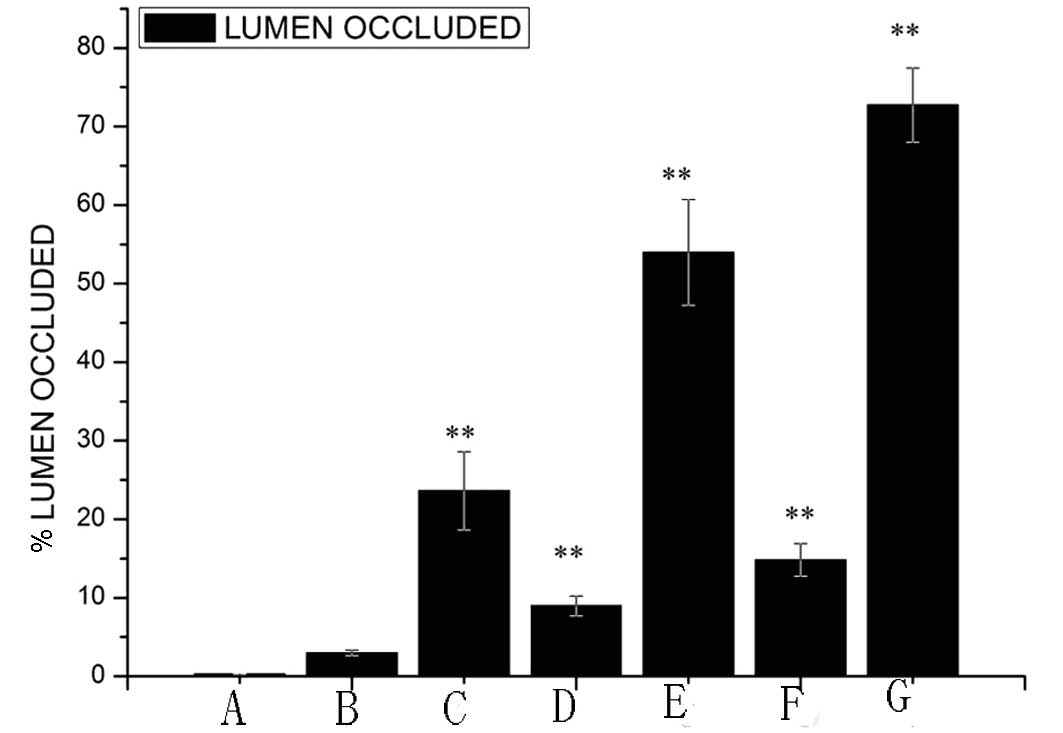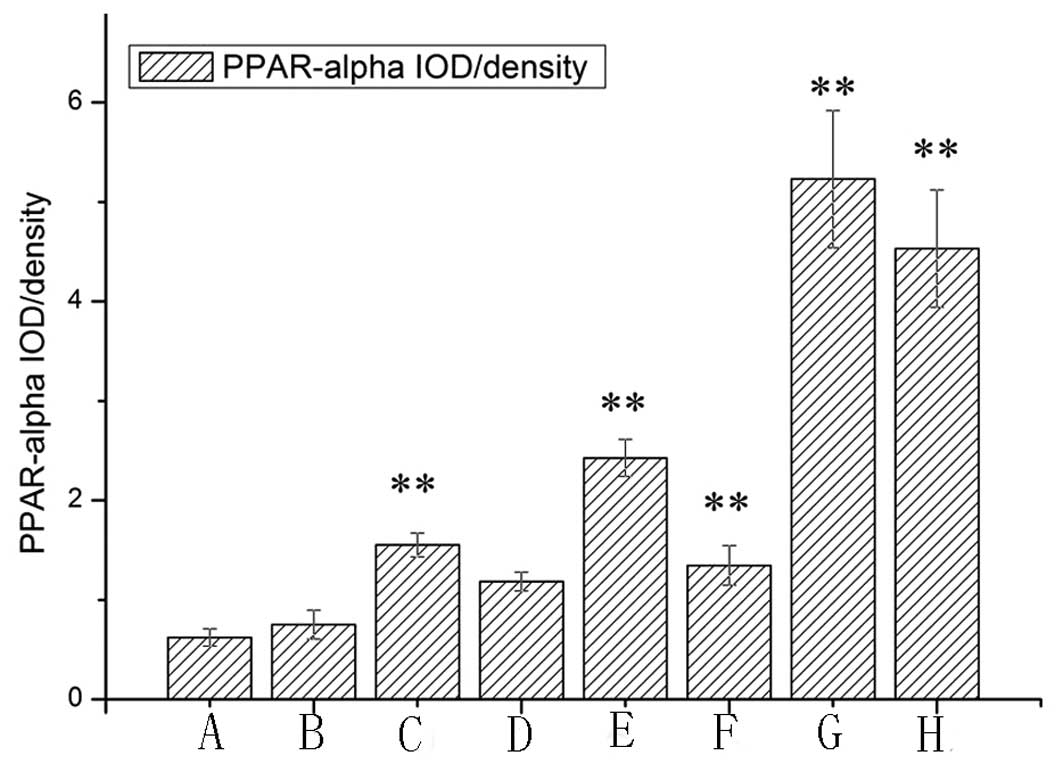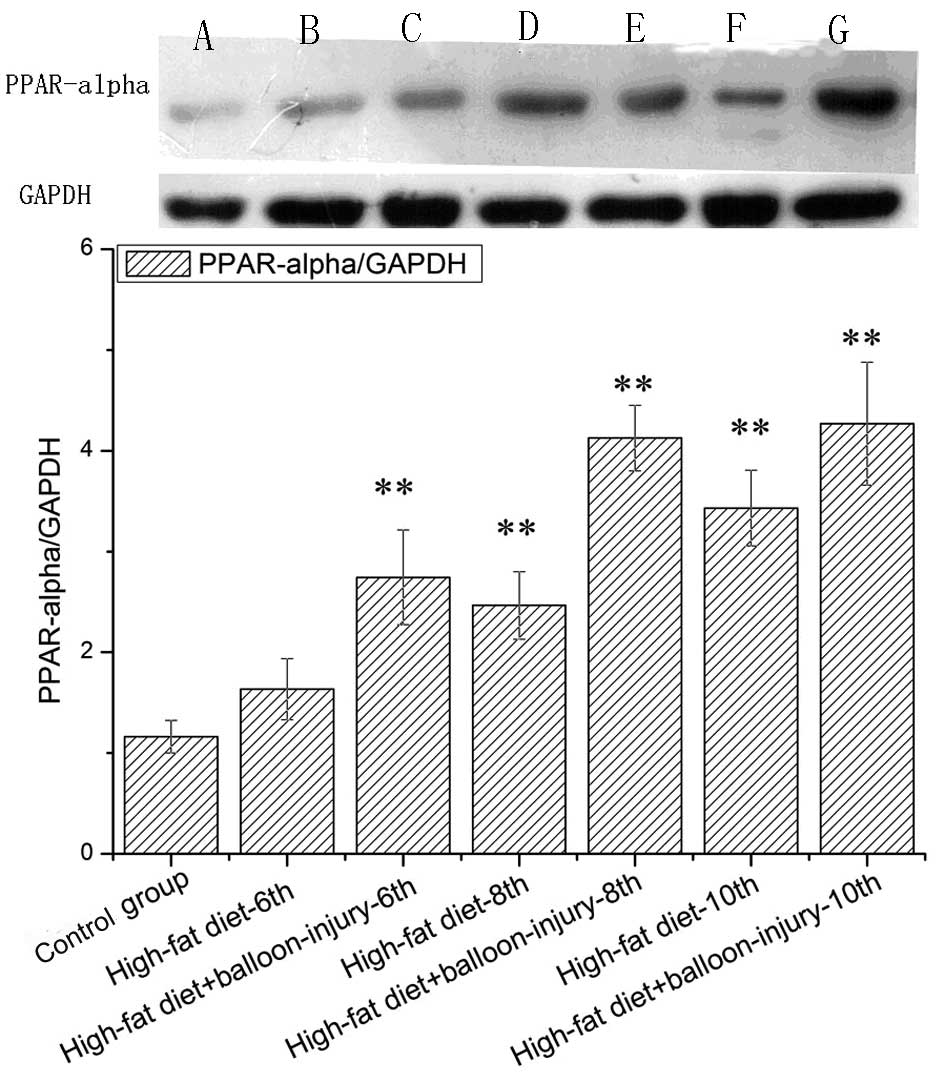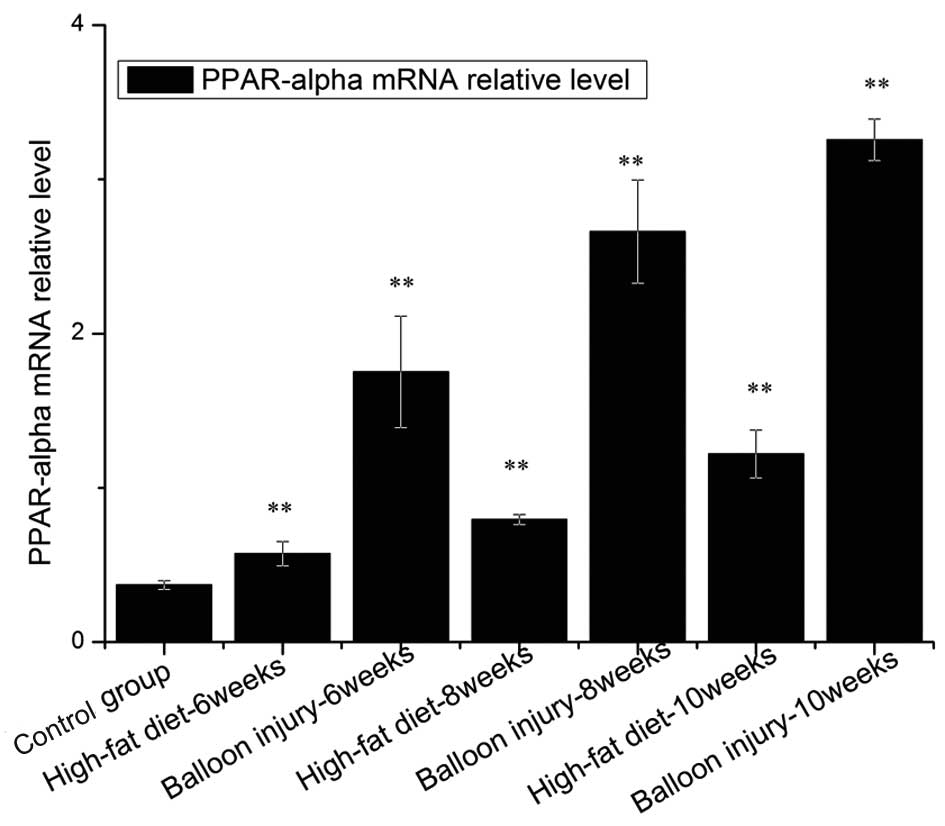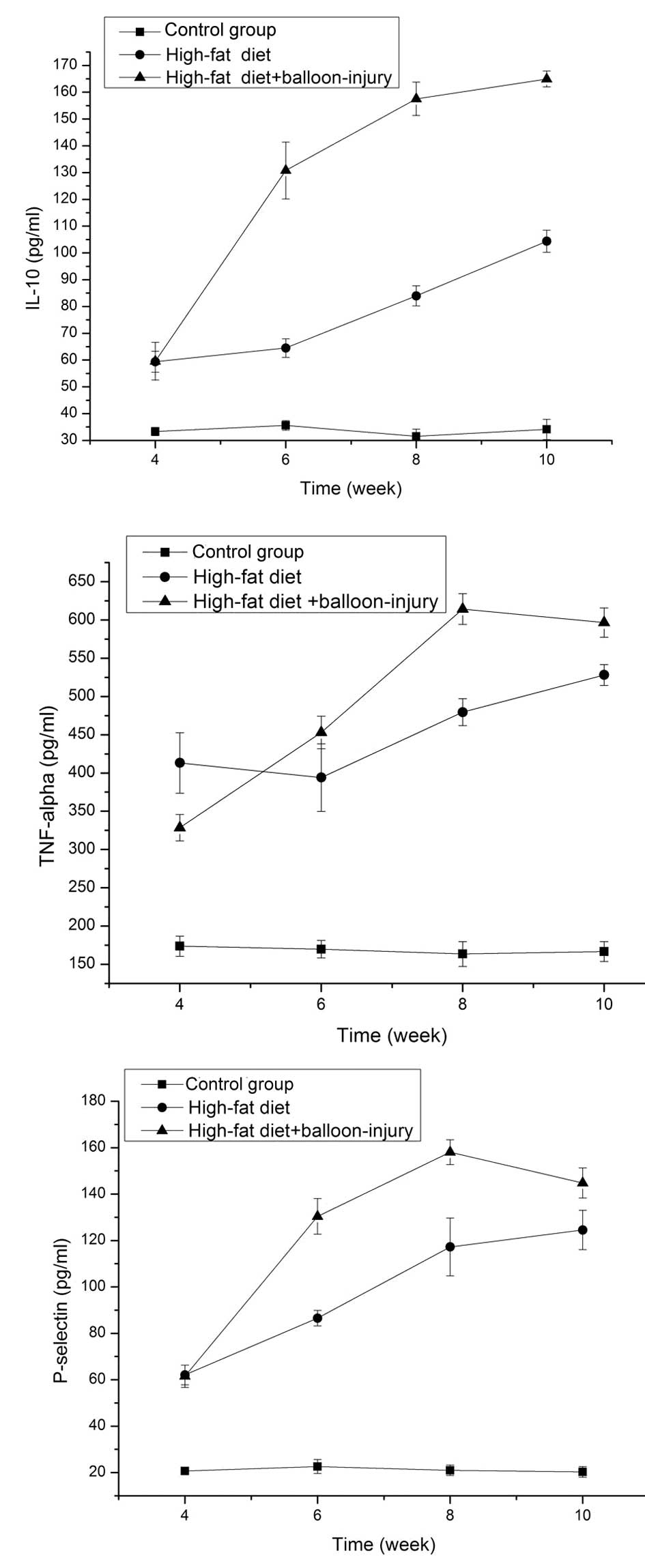|
1
|
Libby P, Ridker PM and Hansson GK:
Progress and challenges in translating the biology of
atherosclerosis. Nature. 473:317–325. 2011. View Article : Google Scholar : PubMed/NCBI
|
|
2
|
Medh JD: Peroxisome proliferator-activated
receptors in atherosclerosis. Curr Opin Lipidol. 10:69–71. 1999.
View Article : Google Scholar : PubMed/NCBI
|
|
3
|
Oyekan A: PPARs and their effects on the
cardiovascular system. Clin Exp Hypertens. 33:287–293. 2011.
View Article : Google Scholar
|
|
4
|
Shah A, Rader DJ and Millar JS: The effect
of PPAR-alpha agonism on apolipoprotein metabolism in humans.
Atherosclerosis. 210:35–40. 2010. View Article : Google Scholar : PubMed/NCBI
|
|
5
|
Kraja AT, Province MA, Straka RJ, Ordovas
JM, Borecki IB and Arnett DK: Fenofibrate and metabolic syndrome.
Endocr Metab Immune Disord Drug Targets. 10:138–148. 2010.
View Article : Google Scholar : PubMed/NCBI
|
|
6
|
Hashizume S, Akaike M, Azuma H, et al:
Activation of peroxisome proliferator-activated receptor α in
megakaryocytes reduces platelet-derived growth factor-BB in
platelets. J Atheroscler Thromb. 18:138–147. 2011.
|
|
7
|
Wagner JD, Shadoan MK, Zhang L, et al: A
selective peroxisome proliferator-activated receptor alpha agonist,
CP-900691, improves plasma lipids, lipoproteins, and glycemic
control in diabetic monkeys. J Pharmacol Exp Ther. 333:844–853.
2010. View Article : Google Scholar
|
|
8
|
Marx N, Sukhova GK, Collins T, Libby P and
Plutzky J: PPARalpha activators inhibit cytokine-induced vascular
cell adhesion molecule-1 expression in human endothelial cells.
Circulation. 99:3125–3131. 1999. View Article : Google Scholar : PubMed/NCBI
|
|
9
|
Mueller M, Hobiger S and Jungbauer A: Red
clover extract: a source for substances that activate peroxisome
proliferator-activated receptor alpha and ameliorate the cytokine
secretion profile of lipopolysaccharide-stimulated macrophages.
Menopause. 17:379–387. 2010.
|
|
10
|
Wofford JL, Kahl FR, Howard GR, McKinney
WM, Toole J and Crouse JR III: Relation of extent of extracranial
carotid artery atherosclerosis as measured by B-mode ultrasound to
the extent of coronary atherosclerosis. Arterioscler Thromb.
11:1786–1794. 1991. View Article : Google Scholar : PubMed/NCBI
|
|
11
|
Buchanan MR and Brister SJ: Inhibition of
chronic vessel wall intimal hyperplasia following acute
anticoagulant treatment: relative effects of heparin and dermatan
sulphate. Thromb Res. 91:157–167. 1998. View Article : Google Scholar
|
|
12
|
Jia XL, Li SY, Dang SS, et al: Increased
expression of chondroitin sulphate proteoglycans in rat
hepatocellular carcinoma tissues. World J Gastroenterol.
18:3962–3976. 2012. View Article : Google Scholar : PubMed/NCBI
|
|
13
|
Campioli E, Batarseh A, Li J and
Papadopoulos V: The endocrine disruptor mono-(2-ethylhexyl)
phthalate affects the differentiation of human liposarcoma cells
(SW 872). PLoS One. 6:e287502011. View Article : Google Scholar : PubMed/NCBI
|
|
14
|
Soymorphin-5, a soy-derived μ-opioid
peptide, decreases glucose and triglyceride levels through
activating adiponectin and PPARα systems in diabetic KKAy mice. Am
J Physiol Endocrinol Metab. 302:E433–E440. 2012.PubMed/NCBI
|
|
15
|
Mottillo EP, Bloch AE, Leff T and
Granneman JG: Lipolytic products activate peroxisome
proliferator-activated receptor (PPAR) α and δ in brown adipocytes
to match fatty acid oxidation with supply. J Biol Chem.
287:25038–25048. 2012.
|
|
16
|
Chinetti G, Gbaguidi FG, Griglio S, et al:
CLA-1/SR-BI is expressed in atherosclerotic lesion macrophages and
regulated by activators of peroxisome proliferator-activated
receptors. Circulation. 101:2411–2417. 2000. View Article : Google Scholar : PubMed/NCBI
|
|
17
|
Sueyoshi S, Mitsumata M, Kusumi Y, et al:
Increased expression of peroxisome proliferator-activated receptor
(PPAR)-alpha and PPAR-gamma in human atherosclerosis. Pathol Res
Pract. 206:429–438. 2010. View Article : Google Scholar : PubMed/NCBI
|
|
18
|
Duhaney TAS, Cui L, Rude MK, et al:
Peroxisome proliferator-activated receptor alpha-independent
actions of fenofibrate exacerbates left ventricular dilation and
fibrosis in chronic pressure overload. Hypertension. 49:1084–1094.
2007. View Article : Google Scholar
|
|
19
|
Dushkin M, Khoshchenko O, Posokhova E and
Schvarts YS: Agonists of PPAR-alpha, PPAR-gamma, and RXR inhibit
the formation of foam cells from macrophages in mice with
inflammation. Bull Exp Biol Med. 144:713–716. 2007. View Article : Google Scholar : PubMed/NCBI
|
|
20
|
Stoll G and Bendszus M: Inflammation and
atherosclerosis: novel insights into plaque formation and
destabilization. Stroke. 37:1923–1932. 2006. View Article : Google Scholar : PubMed/NCBI
|
|
21
|
Kabłak A, Ziembicka TP, Stępień E, et al:
Relationship between carotid intima-media thickness, cytokines,
atherosclerosis extent and a two-year cardiovascular risk in
patients with arteriosclerosis. Kardiol Pol. 69:1024–1031.
2011.PubMed/NCBI
|
|
22
|
Meng X, Zhang K, Li J, et al: Statins
induce the accumulation of regulatory T cells in atherosclerotic
plaque. Mol Med. 18:598–605. 2012. View Article : Google Scholar : PubMed/NCBI
|
|
23
|
Heun R, Kölsch H, Ibrahim-Verbaas CA, et
al: Interactions between PPAR-α and inflammation-related cytokine
genes on the development of Alzheimer’s disease, observed by the
Epistasis Project. Int J Mol Epidemiol Genet. 3:39–47. 2012.
|
|
24
|
Lee JW, Bajwa PJ, Carson MJ, et al:
Fenofibrate represses interleukin-17 and interferon-gamma
expression and improves colitis in interleukin-10-deficient mice.
Gastroenterology. 133:108–123. 2007. View Article : Google Scholar : PubMed/NCBI
|
|
25
|
Donnelly SC, Strieter RM, Reid PT, et al:
The association between mortality rates and decreased
concentrations of interleukin-10 and interleukin-1 receptor
antagonist in the lung fluids of patients with the adult
respiratory distress syndrome. Ann Intern Med. 125:191–196. 1996.
View Article : Google Scholar
|
|
26
|
Rizza S, Cardellini M, Porzio O, et al:
Pioglitazone improves endothelial and adipose tissue dysfunction in
pre-diabetic CAD subjects. Atherosclerosis. 215:180–183. 2011.
View Article : Google Scholar : PubMed/NCBI
|
|
27
|
Parameswaran N and Patial S: Tumor
necrosis factor-α signaling in macrophages. Crit Rev Eukaryot Gene
Expr. 20:87–103. 2010.
|
|
28
|
Hou X, Shen YH, Li C, et al: PPARalpha
agonist fenofibrate protects the kidney from hypertensive injury in
spontaneously hypertensive rats via inhibition of oxidative stress
and MAPK activity. Biochem Biophys Res Commun. 394:653–659. 2010.
View Article : Google Scholar : PubMed/NCBI
|
|
29
|
Rinaldi B, Donniacuo M, Esposito E, et al:
PPARα mediates the anti-inflammatory effect of simvastatin in an
experimental model of zymosan-induced multiple organ failure. Br J
Pharmacol. 163:609–623. 2011.
|
|
30
|
Matta R, Barnard JA, Wancket LM, et al:
Knockout of Mkp-1 exacerbates colitis in Il-10-deficient mice. Am J
Physiol Gastrointest Liver Physiol. 302:G1322–G1335. 2012.
View Article : Google Scholar : PubMed/NCBI
|
|
31
|
Genovese T, Mazzon E, Di Paola R, et al:
Role of peroxisome proliferator-activated receptor-alpha in acute
pancreatitis induced by cerulein. Immunology. 118:559–570.
2006.PubMed/NCBI
|
|
32
|
Johnson RC, Chapman SM, Dong ZM, et al:
Absence of P-selectin delays fatty streak formation in mice. J Clin
Invest. 99:1037–1043. 1997. View Article : Google Scholar : PubMed/NCBI
|
|
33
|
Koh KK, Han SH, Quon MJ, Yeal Ahn J and
Shin EK: Beneficial effects of fenofibrate to improve endothelial
dysfunction and raise adiponectin levels in patients with primary
hypertriglyceridemia. Diabetes Care. 28:1419–1424. 2005. View Article : Google Scholar : PubMed/NCBI
|
|
34
|
Nakamachi T, Nomiyama T, Gizard F, et al:
PPARalpha agonists suppress osteopontin expression in macrophages
and decrease plasma levels in patients with type 2 diabetes.
Diabetes. 56:1662–1670. 2007. View Article : Google Scholar : PubMed/NCBI
|





